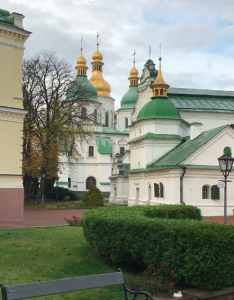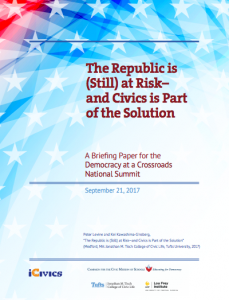I’d welcome recommendations of particularly promising undergraduate courses or programs that are intended to boost students’ civic knowledge, skills, and engagement. I’m especially interested in two approaches: 1) requiring a specific course with a civic focus for all students at a given institution, or 2) offering a major, minor, or certificate program for especially interested students.
Civic education at the college level may address contested concepts (justice, citizenship, democracy), skills (from facilitating meetings to reading regression tables), bodies of knowledge (how a bill becomes a law; the texture of the local geographical community; social determinants of health …), self-understandings and identities (“Who am I and what is my role in the community?”), and relationships among students or between students and others. The list of possible outcomes is so long that one reasonable view is: A civic education is a liberal education–it’s the whole curriculum and co-curriculum. But it’s valuable to consider what to offer (or perhaps even require) in the finite span of one course or one major.
Many colleges and universities require first-year seminars. Students can typically choose a course from a menu, but all the seminars create a similar experience, which is supposed to build a community among the students. To the extent that first-year seminars address issues of civic importance, this is also a way of teaching ideas and skills relevant to citizenship. At Cal. State Chico, the guiding principle of the first year seminar program is “Public Sphere Pedagogy.” Chico aims to shift “from a typical classroom setting” to real public dialogues with “diverse campus and community members.”
Other institutions require a particular course or sequence of courses for all students. Columbia’s Core Curriculum is a distinguished example that dates to the early 1900s. Since Columbia’s Core course on “Literature Humanities” has included the Iliad, Oresteia, and Inferno for all of its 75 years, every Columbia College student since WWII has read those books. “The communal learning–with all students encountering the same texts and issues at the same time–and the critical dialogue experienced in small seminars are the distinctive features of the Core.” One could focus mainly on formal, historical, or theological issues while reading texts like the Inferno; but among the topics emphasized in the Core seminars are explicitly civic ones: “What does it mean, and what has it meant to be part of a community?” “By what rules should we be governed?”
At Florida Gulf Coast University, all 13,000 students must take the University Colloquium, an “interdisciplinary environmental education course designed to explore the concept of sustainability as it relates to a variety of considerations and forces in Southwest Florida. In particular, we will consider environmental, social, ethical, historical, scientific, economic, and political influences.” The Colloquium requires 10 hours of service, which can go toward FGCU’s universal requirement of 80 hours for graduation.
Note the interesting difference in content focus: classic texts at Columbia; the local physical and human environment at FGCU.
At least 31 institutions offer majors with titles like “Civic Engagement,” “Service Learning,” “Civic Leadership,” “Community Service,” or “Leadership, Ethics, and Social Action,” and variations on those themes.* I would add majors in “Peace & Justice Studies,” “Advocacy Studies,” “Citizenship & Civic Engagement,” and others to this list.
These programs almost always require community-service experiences or internships. Most also require a foundational course. Butin* finds that the content of these courses varies a great deal. The most frequently assigned material is research about civic engagement in America, e.g., Robert Putnam’s Bowling Alone or excerpts from de Tocqueville; but those particular texts are assigned in a minority of all the foundational courses.
Majors are usually more ambitious than minors or certificates, but a program like the University of Maryland’s Civicus is not only a certificate with some required courses; participants also live together in a dedicated dorm and conduct service projects beyond their courses. In that situation, a certificate may be more intensive than a major.
I view public policy programs (whether undergraduate or graduate) as somewhat different from programs in civics. I like to say that the question for Civic Studies is “What should we do?” whereas the question for public policy is “What should be done?” (Or, “What should a policymaker do?”) However, public policy programs can emphasize the citizen’s side of policymaking. Some assign all their students to participate in simulations in which they role-play various official leaders in a fictional crisis. These simulations typically fill a limited number of days before the main coursework begins and serve to build a community while teaching civic skills. I am not aware of any institution that offers or requires a simulation for its whole undergraduate student body, but that’s an interesting prospect.
* Dan Butin, “’Can I major in Service-Learning?’ An Empirical Analysis of Certificates, Minors, and Majors,” Journal of College & Character, vol. 11, No. 2 (2010), pp. 1-18.





